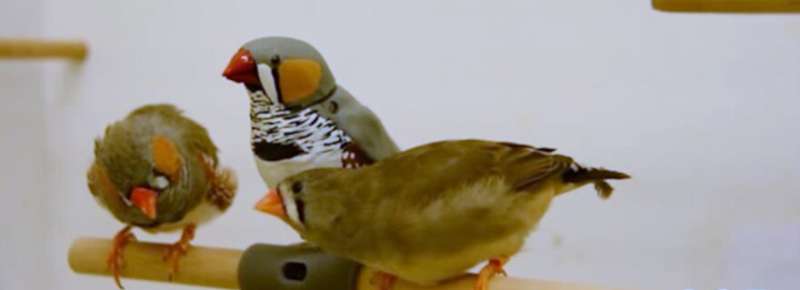This article has been reviewed according to Science X's editorial process and policies. Editors have highlighted the following attributes while ensuring the content's credibility:
fact-checked
peer-reviewed publication
trusted source
proofread
Robo-bird teaches young zebra finches to sing

How do young zebra finches learn to sing? A research team led by researcher Katharina Riebel has developed a "RoboFinch" to study just that. She and colleagues in the "Seeing voices" research consortium have spent the past four years designing the robotic bird. And with success—young zebra finches listen keenly to it.
"Like children, young zebra finches start by babbling. They hear other birds singing, memorize this and start practicing," says Riebel, a researcher at the Institute of Biology Leiden (IBL).
"To investigate when and how birds learn, researchers have mostly played birdsong through loudspeakers. This was sometimes in combination with a screen, but didn't get any further than 2D. However, singing involves much more, such as beak and throat movements and posture. This might be why young birds learn less well from a loudspeaker than from another bird."
Riebel's research group therefore developed the RoboFinch, together with VU Amsterdam and Freie Universität Berlin. This started with a 3D scan and 3D print of an adult male. As birds see colors differently from humans, the paint that was used for the robots was adjusted to how zebra finches see color. This made the robot seem lifelike to zebra finches.
Fast-moving beaks
Using high-speed cameras, the research group filmed and then precisely measured the beak movements of zebra finches to make an exact copy. "At the VU workplace, they said this would be a challenge. The beaks move so fast," says Riebel.
"Yet they managed it in the end. An incredible achievement. And besides making the bird move properly, we have now perfectly synchronized several songs. That had to be done frame by frame, so at 120 frames per second, you can understand that it was an awful lot of work for the team."
Young birds interact with RoboFinch
Fortunately, the RoboFinch was an immediate success with the birds. "Zebra finches are often hesitant at first when they experience something new, but now they were immediately extremely curious," says Judith Varkevisser, who conducted the experiments.
"They come and sit next to the robotic bird on the perch and twitter at it. More importantly, the young birds sit still and study the RoboFinch when it starts moving and we play birdsong. They really seem to be listening to the robot! This proves we can use the RoboFinch in our studies of vocal learning and whether seeing the movements involved in singing are important for this."
This positive result means Riebel and her team can now put together the different components of birdsong like a building kit. "Do we want only movement or audio, or to play everything together? And we will also try to make the RoboFinch interactive: then it can start singing as soon as the birds sit on a certain perch."
Make your own robo-bird
The study is published in the journal Methods in Ecology and Evolution. With the publication, Riebel's group is also providing all codes and instructions to make your own robot. "So anyone, any research group, can give it a try. It was only possible for us to develop the RoboFinch because of the Human Frontiers grant," says Riebel
"It was a high-risk project because we didn't know whether we would be able to build a robot the birds would accept. Now we are happy to share the blueprint with others and hope to discover even more about vocal learning. We are eager to see what else we can discover in the coming years."
More information: Ralph Simon et al, RoboFinch: A versatile audio‐visual synchronised robotic bird model for laboratory and field research on songbirds, Methods in Ecology and Evolution (2023). DOI: 10.1111/2041-210X.14063
Journal information: Methods in Ecology and Evolution
Provided by Leiden University




















